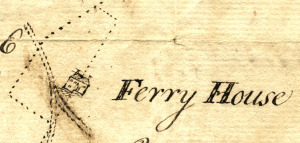This article is a continuation of the article by Egbert T. Bush titled “When Stockton Was Not So Dry.” (Part One and Part Two.) Today I will enlarge on Mr. Bush’s short history of the Stockton Inn, which is now for sale. It is my hope that by fleshing out this history, a purchaser might be found who will value it as well as the lovely architecture of the place.
taverns
When Stockton Was Not So Dry, part two
This part of Mr. Bush’s article deals primarily with the history of the tavern in Stockton, which began its life across the road from the Sharp-Lambert store (part one), but ended it as the Stockton Inn, at Bridge and Main Streets. (As usual, Mr. Bush’s article is in italics and my comments are not.)
How Locktown Got Its Name
Back in February, I published an article on the cemetery connected with the Locktown Baptist church. Previously I have written about the Baptist congregation here as well as the Locktown Christian Church and its Cemetery. It seems appropriate now to include Mr. Bush’s own history of this neighborhood, which was published in the Hunterdon Democrat, on May 22, 1930. Along with the churches, Mr. Bush discusses the school house, the distillery and the Locktown Hotel, which began its life as a humble tavern, and also some of the old families, like the Chamberlins, Heaths, Lairs, Rittenhouses, Smiths and Suttons. Photographs in this article were provided by Paul Kurzenberger.
A House Divided
Howell’s Tavern House and Ferry House

click to enlarge
The dotted line in this picture is a survey line, drawn by Reading Howell in 1774, and as you can see, one of the lines goes right through the middle of the house, which is labeled “Ferry House.” Strangely enough, this house has long been known as the tavern house at Howell’s Ferry (Stockton) which I wrote about in “Jacob’s Path, an 1813 Shortcut.” So why was the tavern house called the Ferry House in 1774? And why did the surveyor run a line right through the middle? Therein lies a story.
Anderson’s Tavern
Recently I had the pleasure of visiting the old John Anderson tavern on Route 31 south of Ringoes. The building is inconspicuous with its tall evergreen hedge along the road, but inside one can see it was once a fine 18th century building.
Daniel Rittenhouse of Locktown
One of the most notable people in the neighborhood of Locktown in Hunterdon County was Daniel Rittenhouse. His life makes an interesting story, which we know something of thanks to the collection known as The Rittenhouse Papers, on file at the Hunterdon County Historical Society.
Boarshead Tavern in the 18th Century
A follow-up to Egbert T. Bush’s article, “Boarshead Tavern One of the Earliest to be Established”
In 1896, Egbert T. Bush presented a paper to the Hunterdon County Historical Society titled “Croton and Vicinity.”1 As part of his survey, Mr. Bush gave a brief history of the Boarshead Tavern.
Delilah Buchanan’s Tavern License Application
I sometimes lose track of the information I have collected in my researches. Today I stumbled across these photographs I took of Delilah Buchanan’s 1829 tavern license application, on file at the Hunterdon County Archives. Delilah Buchanan got a lot of my attention while researching Buchanan’s Tavern. (The series of articles can be found by clicking on the topic in the right-hand column.)
Boarshead Tavern
Boarshead Tavern One of the Earliest to be Established
Efforts to Find How Long It Has Stood Have Been In Vain
Dr. Pyatt’s Varied Career
By Egbert T. Bush, Stockton, N.J.
Continue reading »
The Jubilee Continues
Now the fun begins–the 1826 Celebration of the Fourth of July in Flemington, NJ. (Part Two of the reprint of my article in the Hunterdon Historical Newsletter, Spring 2006. You can read Part One here.)Continue reading »
